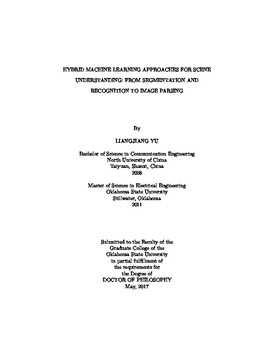| dc.contributor.advisor | Fan, Guoliang | |
| dc.contributor.author | Yu, Liangjiang | |
| dc.date.accessioned | 2018-03-13T18:16:34Z | |
| dc.date.available | 2018-03-13T18:16:34Z | |
| dc.date.issued | 2017-05 | |
| dc.identifier.uri | https://hdl.handle.net/11244/54636 | |
| dc.description.abstract | We alleviate the problem of semantic scene understanding by studies on object segmentation/recognition and scene labeling methods respectively. We propose new techniques for joint recognition, segmentation and pose estimation of infrared (IR) targets. The problem is formulated in a probabilistic level set framework where a shape constrained generative model is used to provide a multi-class and multi-view shape prior and where the shape model involves a couplet of view and identity manifolds (CVIM). A level set energy function is then iteratively optimized under the shape constraints provided by the CVIM. Since both the view and identity variables are expressed explicitly in the objective function, this approach naturally accomplishes recognition, segmentation and pose estimation as joint products of the optimization process. For realistic target chips, we solve the resulting multi-modal optimization problem by adopting a particle swarm optimization (PSO) algorithm and then improve the computational efficiency by implementing a gradient-boosted PSO (GB-PSO). Evaluation was performed using the Military Sensing Information Analysis Center (SENSIAC) ATR database, and experimental results show that both of the PSO algorithms reduce the cost of shape matching during CVIM-based shape inference. Particularly, GB-PSO outperforms other recent ATR algorithms, which require intensive shape matching, either explicitly (with pre-segmentation) or implicitly (without pre-segmentation). On the other hand, under situations when target boundaries are not obviously observed and object shapes are not preferably detected, we explored some sparse representation classification (SRC) methods on ATR applications, and developed a fusion technique that combines the traditional SRC and a group constrained SRC algorithm regulated by a sparsity concentration index for improved classification accuracy on the Comanche dataset. Moreover, we present a compact rare class-oriented scene labeling framework (RCSL) with a global scene assisted rare class retrieval process, where the retrieved subset was expanded by choosing scene regulated rare class patches. A complementary rare class balanced CNN is learned to alleviate imbalanced data distribution problem at lower cost. A superpixels-based re-segmentation was implemented to produce more perceptually meaningful object boundaries. Quantitative results demonstrate the promising performances of proposed framework on both pixel and class accuracy for scene labeling on the SIFTflow dataset, especially for rare class objects. | |
| dc.format | application/pdf | |
| dc.language | en_US | |
| dc.rights | Copyright is held by the author who has granted the Oklahoma State University Library the non-exclusive right to share this material in its institutional repository. Contact Digital Library Services at lib-dls@okstate.edu or 405-744-9161 for the permission policy on the use, reproduction or distribution of this material. | |
| dc.title | Hybrid machine learning approaches for scene understanding: From segmentation and recognition to image parsing | |
| dc.contributor.committeeMember | Hagan, Martin T. | |
| dc.contributor.committeeMember | Sheng, Weihua | |
| dc.contributor.committeeMember | Crick, Christopher John | |
| osu.filename | Yu_okstate_0664D_15044.pdf | |
| osu.accesstype | Open Access | |
| dc.type.genre | Dissertation | |
| dc.type.material | Text | |
| thesis.degree.discipline | Electrical Engineering | |
| thesis.degree.grantor | Oklahoma State University | |
